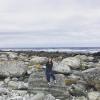final course reflection on my portfolio
By kcroninMay 2, 2018 - 08:36
Throughout the semester, I have been interested in pursuing the disability studies perspective in medical decision making. At the beginning of the semester, I had focused my thoughts on how medical technology impacts the disability community. As the semester progressed, I became interested in topics related to how our perception of disability shapes our decisions when faced with questions regarding informed consent or physician-assisted suicide. Through exploring these topics, I developed the idea that the relationship between disability and health is largely responsible for the stigma related to disability. My understanding of both medicine and disability expanded as a result of these reflections.




